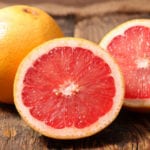 Technology
Technology  Technology
Technology  Humans
Humans 10 Everyday Human Behaviors That Are Actually Survival Instincts
 Animals
Animals 10 Animals That Humiliated and Harmed Historical Leaders
 History
History 10 Most Influential Protests in Modern History
 Creepy
Creepy 10 More Representations of Death from Myth, Legend, and Folktale
 Technology
Technology 10 Scientific Breakthroughs of 2025 That’ll Change Everything
 Our World
Our World 10 Ways Icelandic Culture Makes Other Countries Look Boring
 Misconceptions
Misconceptions 10 Common Misconceptions About the Victorian Era
 Mysteries
Mysteries 10 Strange Unexplained Mysteries of 2025
 Miscellaneous
Miscellaneous 10 of History’s Most Bell-Ringing Finishing Moves
 Technology
Technology Top 10 Everyday Tech Buzzwords That Hide a Darker Past
 Humans
Humans 10 Everyday Human Behaviors That Are Actually Survival Instincts
 Animals
Animals 10 Animals That Humiliated and Harmed Historical Leaders
Who's Behind Listverse?

Jamie Frater
Head Editor
Jamie founded Listverse due to an insatiable desire to share fascinating, obscure, and bizarre facts. He has been a guest speaker on numerous national radio and television stations and is a five time published author.
More About Us History
History 10 Most Influential Protests in Modern History
 Creepy
Creepy 10 More Representations of Death from Myth, Legend, and Folktale
 Technology
Technology 10 Scientific Breakthroughs of 2025 That’ll Change Everything
 Our World
Our World 10 Ways Icelandic Culture Makes Other Countries Look Boring
 Misconceptions
Misconceptions 10 Common Misconceptions About the Victorian Era
 Mysteries
Mysteries 10 Strange Unexplained Mysteries of 2025
 Miscellaneous
Miscellaneous 10 of History’s Most Bell-Ringing Finishing Moves
Top 20 Fruits You Probably Don’t Know
I was playing a game the other day in which you have to come up with fruit that starts with every letter of the alphabet. Apple, banana, cherry … and that is about where I hit a blank. My epic failure at this game made me do some research and what I discovered was a whole world of delicious-looking fruit that I had never even known about! I was completely shocked to find that there are actually hundreds of different types of fruit (no need to include them all as omissions in the comments), most of which I had never even heard of. This list is not to rank the fruit but rather just to inform you about them. The only fruit on this list I consider ranked is No: 1, as it deserves the spot, in clearly being the coolest fruit on the planet. How many of these exotically delicious fruits have you tried?
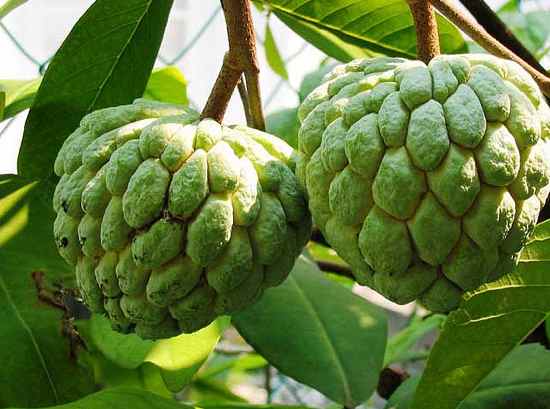
Sugar Apples or Sweetsop is native to the tropical Americas but is also widely grown in Pakistan, India, and the Philippines. The fruit looks a bit like a pine cone and is about 10 cm in diameter. Under the hard, lumpy skin is the fragrant, whitish flesh of the fruit, which covers several seeds inside, and has a slight custard taste.
Wallow in the delicious flavor of dried fruit when you buy Bare Fruit Organic Variety Pack, Gluten Free Baked Snacks at Amazon.com!
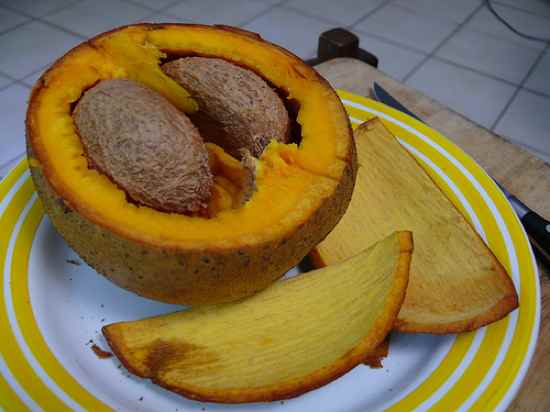
Mammee Apple, Mamey Apple, or Santo Domingo Apricot is an evergreen tree native to South America, introduced to various other regions of the world, including West Africa and Southeast Asia. They can also be found in Florida and Hawaii. The Mammee apple is actually a berry and gets up to 20 cm in diameter. It has a thick outer rind, with soft orange to yellow pulp on the inside. It usually has one seed in the centre, but larger fruit have been known to carry up to 4. The pulp is sweet and fragrant.
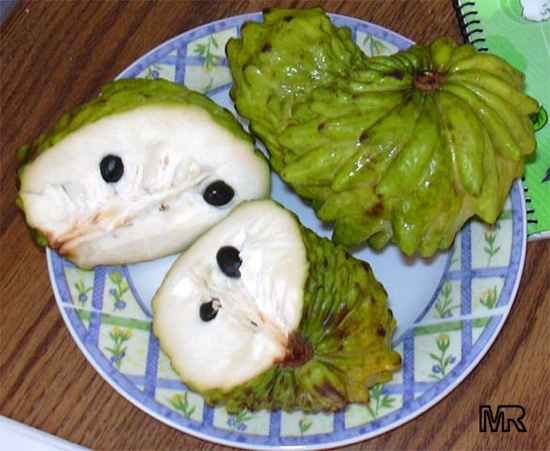
Cherimoya, or custard apple, is a deciduous plant found in the high lying mountainous areas of South America. The fruit is vaguely round and is found with 3 types of skin – Impressa (indented), Tuberculate (covered in nodules), or intermediate (a combination of the first two). The flesh inside the skin is very fragrant, white, juicy, and has a custard-like consistency. It is said that the fruit tastes like a combination of banana, passion fruit, papaya, and pineapple. Mark Twain said in 1866 “ the most delicious fruit known to men, cherimoya”
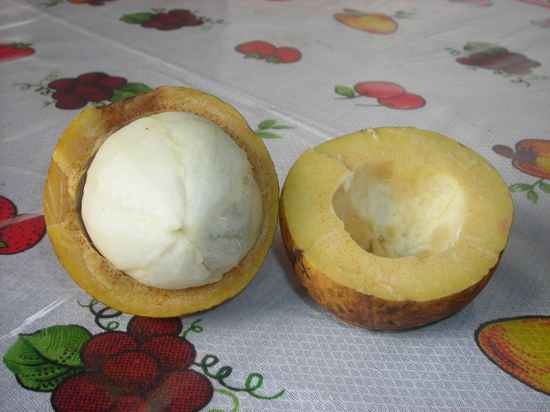
Platonia or Bacuri is a large tree (reaching 40m) found in the rain forests of Brazil and Paraguay. The fruit becomes the size of an orange and has a thick yellow peel that oozes a yellow latex when pressed. Inside, a sticky white pulp is wrapped around several black seeds, which tastes pleasant and has a sweet and sour flavor.
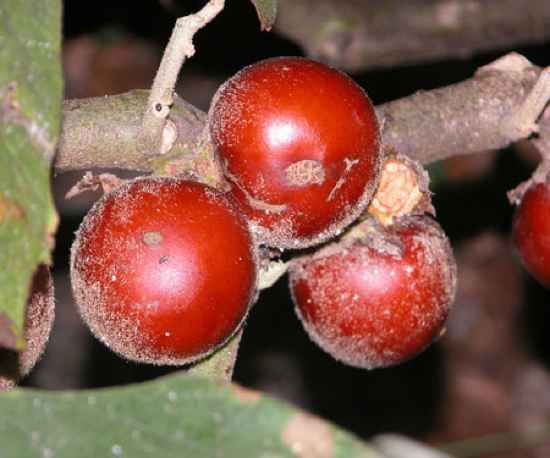
Cocona fruit is another tropical fruit found in the mountainous regions of South America. It grows on a small shrub and can miraculously grow from seed to fruit in less than 9 months, after which the fruit will take another 2 months to ripen. The fruit is a berry and comes in red, orange, or yellow. It has a similar appearance to tomatoes and tastes like a mixture between tomatoes and lemons.
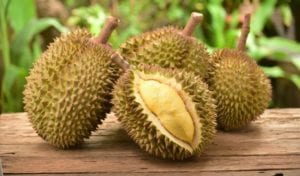
Durian grows in tropical regions around the world, particularly in the Southeast Asian countries of Malaysia, Indonesia, and Thailand. The fruit is distinguished by its large size and spiky, hard outer shell. It has a smelly, custard-like flesh with large seeds. There are several varieties, but the most common one is Durio zibethinus. The fruit’s flesh can range in color. It’s most commonly yellow or white but can also be red or green. The fruit can grow up to 1 foot (30 cm) long and 6 inches (15 cm) wide. A typical durian fruit has about 2 cups (486 grams) of edible pulp.
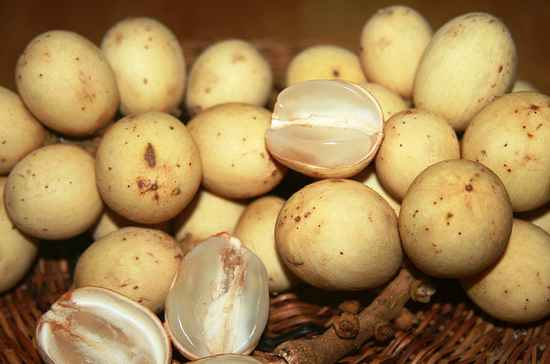
Duku or lungsat are two very similar fruits found throughout Asia. They come from the same family, look and taste identical, with one difference. The skin of the lungsat contains a latex substance, which is not poisonous but causes the skin to stick slightly to the fruit, whereas the duku has no latex, and the peel is removed with more ease. Inside, the fruit has 5 segments, some of which have bitter seeds inside. It is a very sweet fruit and can be prepared in a number of different ways, including being canned in syrup or being dried like raisins.
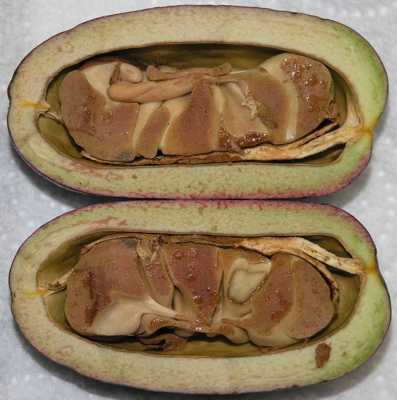
Safou is an evergreen tree found in the humid tropical forests of Africa, as far south as Angola and as far north as Nigeria. The fruits are also known as African pears and are oblong dark blue to violet fruits up to 14cm in length, with pale green flesh inside. These fatty fruits have been said to have the ability to end starvation in Africa, as 48% of the fruit is made up of essential fatty acids, amino acids, Vitamins, and triglycerides. They have estimated that a one-hectare plantation would produce 7-8 tons of oil, and all parts of the plant can be used.

Jabuticaba, or the Brazilian grape tree, is a very strange plant native to the South Eastern parts of Brazil. What makes this plant so strange is that it fruits from its trunk. No, I did not make that up, and no the picture has not been photoshopped. Initially, yellowish-white flowers will appear all over the trunk and main branches. These flowers will then turn into fruit, about 3 – 4cm in diameter. Inside the thick purple skin is the soft gelatinous flesh of the fruit, along with 1 – 4 black seeds. The fruit is sweet and can be eaten as is or made into a wine or liqueur. Unfortunately, the fruit does not keep long when off the tree and will start to ferment after about 3 or 4 days.
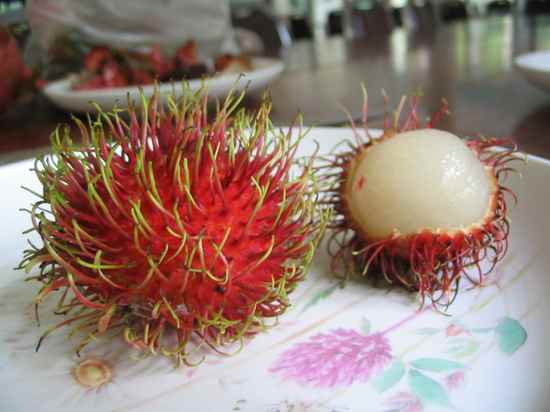
Rambutan is an odd fruit that looks like a furry strawberry from the outside and much like a lychee on the inside. It is native to South East Asia but has been spread, and a smaller “wild” version can be found in Costa Rica, where it is called a Chinese sucker. The fruit is an oval shape and about 3-6 cm in diameter. Inside the slightly hard but easily peelable skin, you can find a soft fruit that tastes slightly sweet, with a possible sour tinge.
Boost your health with Daily Tips for Healthy Living at Amazon.com!
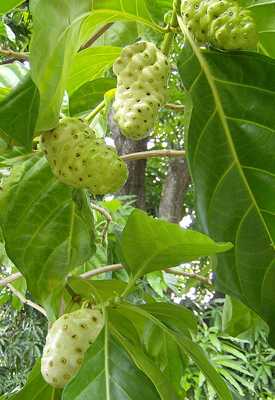
Noni, otherwise known by many different names worldwide, including the great moringa, Indian mulberry, dog dumpling, and pace, is related to the coffee bean plant and is native throughout South East Asia and Australasia is cultivated throughout the tropics. The tree carries fruit throughout the year, and the fruit tends to have a very pungent odour when ripening (also known as the cheese fruit or vomit fruit). Despite the smell, the fruit is high in fibre, vitamin A, protein, iron, and calcium and is the staple diet on many Pacific Islands. The fruit can either be cooked into a stew or eaten raw with salt.
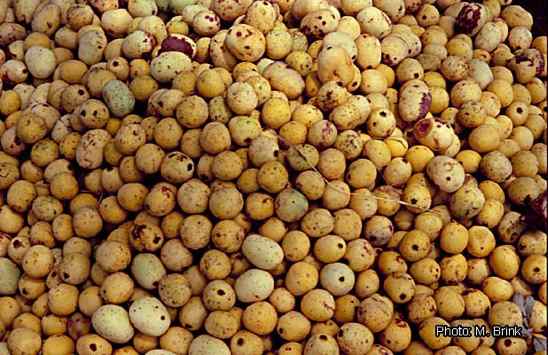
The Marula is a deciduous tree native to Southern and Eastern Africa. The distribution of the tree throughout Africa follows the Bantu people’s migratory patterns, as it was an important source of food, and they planted more trees along their way. The green fruit ripens and turns yellow; the white flesh inside is succulent and has a very distinct flavor. After falling off the tree, the fruit will start to ferment, and these draw in animals, like elephants and baboons, for a slightly alcoholic treat. The fruit is also used to make a popular liqueur called Amarula, which can be found at any duty-free liquor store at airports.
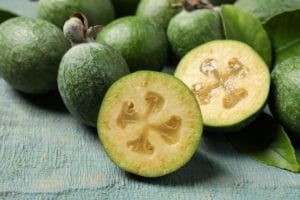
This subtropical plant originated in the higher altitude regions of central South America but has since been introduced and grown commercially in Europe, California, New Zealand, South Africa, and southern Russia. Feijoas taste like taking the best elements of strawberry, guava, and pineapple and mixing them together. They smell pleasantly sweet and flowery. To eat a feijoa, cut (or rip) it in half and scoop out the inside creamy white flesh (a little brownish color is OK to eat). Feijoas are a good source of vitamin C, fiber, and potassium, even containing a little protein. The fruit matures in autumn, is green, ellipsoid, and about the size of a chicken egg.
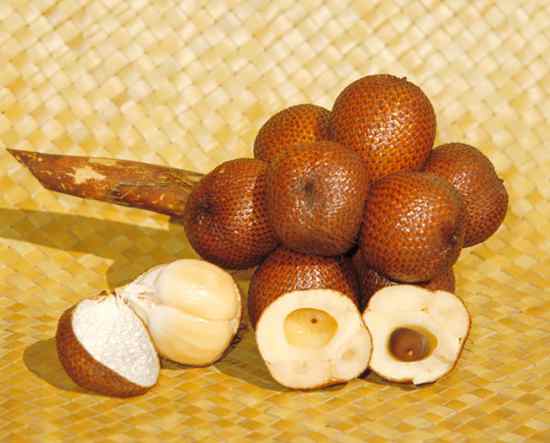
Salak fruit, also known as the snake fruit, comes from a species of palm native to Indonesia. These fruits grow at the base of the palm and gained the name snake fruit from their red-brown, scaly skin. The skin is easily removed, and inside are 3 white, sweet segments that each contain a large black inedible seed. When eaten, the fruit has a slightly acidic but sweet flavor and the consistency of apples.
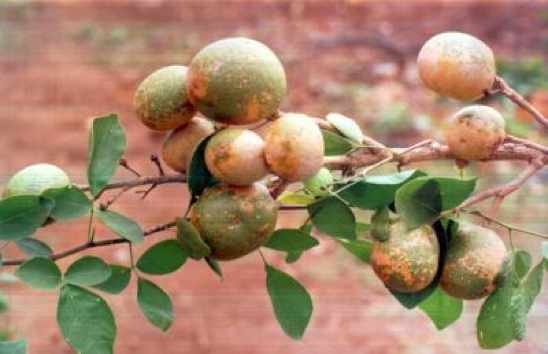
Bael, wood apple, or stone apple is a species native to India but found throughout Southeast Asia. Bael is a smooth fruit with a woody peel that is colored yellow, green, or grey. The hard, woody, outer peel is so hard that it has to be cracked with a hammer. Inside is an aromatic yellow pulp with several hairy seeds. The flesh can be eaten either dried or fresh. A juice called sharbat can be made from the fresh fruit, adding water, sugar, and lime juice to the pulp. It takes just one large fruit to make 6 liters of sharbat.
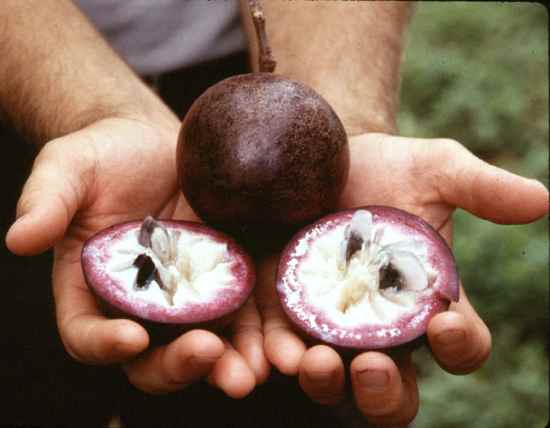
The Star apple is a fruit native to the low-lying areas of Central America and the West Indies. The underside of the evergreen leaves shine with a golden color from a distance, and the tree carries small white to purple flowers with a sweet fragrance. The fruit is round, purple, and has thick, latex-filled skin. If the fruit is cut horizontally, a clear star pattern can be seen in the white, purple pulp. The fruit is deliciously fresh, with an intensely sweet taste.
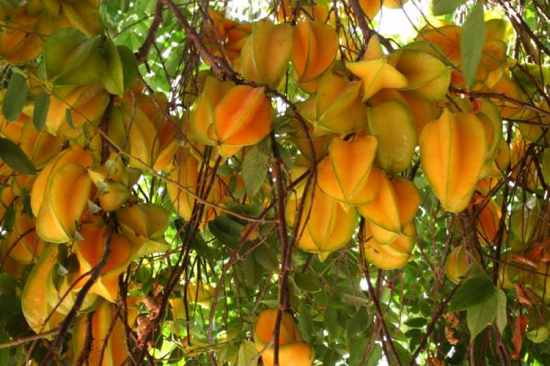
Star fruit or carambola is a fruit tree native to the Philippines but can be found throughout Southeast Asia, East Asia, South America, Florida, and Hawaii. This fruit has five ridges running down its length, which, when cut sideways, makes the star pattern after which it is named. The fruit is rich in Vitamin C and Antioxidants. When ripe, the fruit turns a bright yellow with waxy skin, and the entire fruit is edible, juicy, and crunchy.
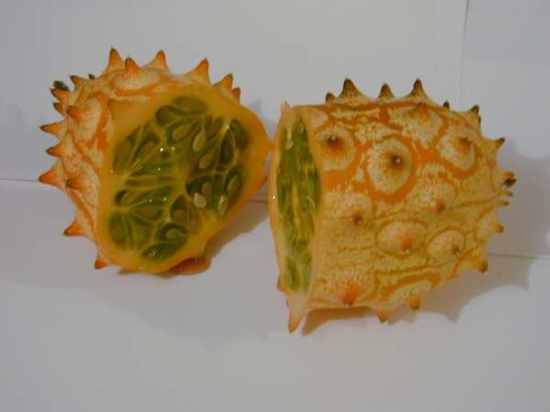
The horned melon, also known as African cucumber or jelly melon, is an annual vine native to Africa but can now be found growing in California, Australia, New Zealand, and Chile as well. The melon has a thick spiky yellow outer skin when ripe, with bright green, jelly-like flesh. The flesh is often compared to the taste of a banana, with the texture of the seedy part of a cucumber or tomato. The thick skin can be eaten and is a good source of vitamin C and fibre.
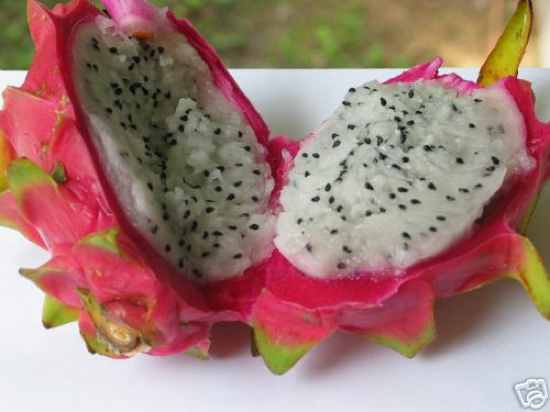
Pitaya, or dragon fruit, is a cactus fruit found throughout Asia, Australasia, North America, and South America, even though they are believed to be native to Mexico originally. There are two main types of pitaya, the sour types, typically eaten in the Americas, and sweet types found across Asia. The fruit comes in 3 different color varieties, Labelled as red, yellow, and Costa Rican pitayas. The “red” fruits are generally a bright magenta color on the outside, with yellow flesh. The Yellow Pitaya is yellow inside and out, and the Costa Rican pitayas are magenta on the outside and the inside. They smell deliciously fragrant, and most have a sweet flavor similar to kiwi fruit.

The miracle fruit, or sweet berries, is a very strange berry native to West Africa. What makes the fruit strange and miraculous is miraculin (a sugar substitute) found in large quantities in the fruit, combined with a glycoprotein. The fruit itself does not contain a lot of sugar and tastes only mildly sweet. Still, when eaten, the glycoprotein binds to the tongue’s taste buds, distorting any other taste into sweetness for about an hour after eating the fruit. With that effect, you could technically eat a lemon, and it would taste like a ball of syrup. Although the definite reason for this occurrence is not fully understood, it would seem as if the miraculin distorts the shape of the sweetness receptors in the tongue to pick up on acid instead of sweetness. The sweetness receptors on your tongue then transmit to the brain to taste sweetness when they contact any acidity. In the 70s, attempts were made to commercialize and sell the fruit as a diet aid, as it has the potential to turn any meal sweet without affecting your calorie intake. These attempts were shattered when the FDA declared it a food additive due to pressure from sugar companies who could foresee big losses in profits. In the last two years, the berries have been making a comeback by being the guest star of many tasting parties in the states. The berries are dried and exported, and the party guests each have one and then taste all kinds of common foods to experience a new taste sensation with every bite.





